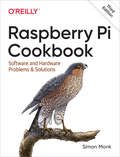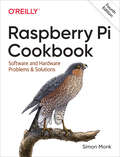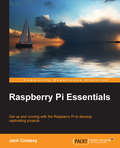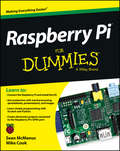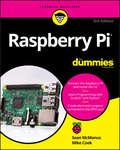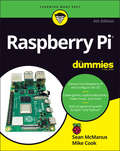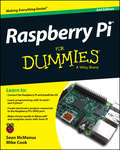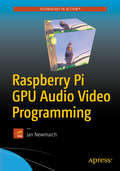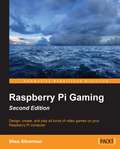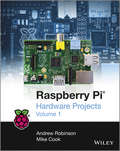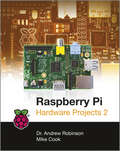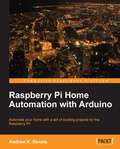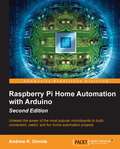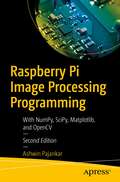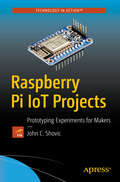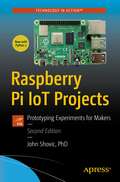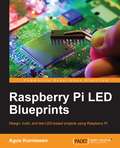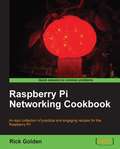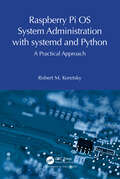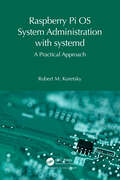- Table View
- List View
Raspberry Pi Cookbook: Software and Hardware Problems and Solutions
by Simon MonkWith millions of new users and several new models, the Raspberry Pi ecosystem continues to expand—along with many new questions about the Pi’s capabilities. The third edition of this popular cookbook provides more than 200 hands-on recipes that show you how to run this tiny low-cost computer with Linux; program it with Python; hook it up to sensors, motors, and Arduino boards; and even use it with the internet of things (IoT).Prolific hacker and author Simon Monk also teaches basic principles to help you use new technologies with the Raspberry Pi. This cookbook is ideal for programmers and hobbyists familiar with the Pi through resources such as Getting Started with Raspberry Pi (O’Reilly). Code examples from the book are available on GitHub.Set up your Raspberry Pi and connect to a networkWork with its Linux-based operating systemProgram your Raspberry Pi with PythonGive your Pi "eyes" with computer visionControl hardware through the GPIO connectorUse your Raspberry Pi to run different types of motorsWork with switches, keypads, and other digital inputsUse sensors to measure temperature, light, and distanceConnect to IoT devices in various ways and automate your home
Raspberry Pi Cookbook: Software and Hardware Problems and Solutions
by Simon MonkIf you've started to work with Raspberry Pi, you know that Raspberry Pi's capabilities are continually expanding. The fourth edition of this popular cookbook provides more than 200 hands-on recipes (complete with code) that show you how to run this tiny low-cost computer with Linux, program it with Python, hook it up to sensors and motors, and use it with the internet of things (IoT). This new edition includes new chapters on the Raspberry Pi Pico and machine learning with the Raspberry Pi.These easy-to-use recipes will show you, step-by-step, how to:Set up your Raspberry Pi and connect to a networkWork with its Linux-based operating systemProgram your Raspberry Pi with PythonGive your Pi "eyes" with computer visionRecognize objects from video and sounds using machine learningControl hardware through the GPIO connectorUse your Raspberry Pi to run different types of motorsWork with switches, keypads, and other digital inputsUse sensors to measure temperature, light, and distanceConnect to IoT devices in various ways and automate your homeUse the Raspberry Pi Pico microcontroller board with your Raspberry Pi
Raspberry Pi Essentials
by Jack CreaseyProgrammers new to the Raspberry Pi and novice programmers with little to no experience with micro board computing will find the book useful. A basic knowledge of programming languages in general will prove useful for a better understanding of the topics.
Raspberry Pi For Dummies
by Sean Mcmanus Mike CookEmbrace the exciting new technology of Raspberry Pi!With the invention of the unique credit-card sized single-board computer, the Raspberry Pi, comes a new wave of hardware geeks, hackers, and hobbyists who are excited about the possibilities of the Raspberry Pi, and this is the perfect guide to get you started in this exhilarating new arena. With this fun and friendly book, you'll quickly discover why the supply for the Pi cannot keep up with the demand! Veteran tech authors Sean McManus and Mike Cook show you how to download and install the operating system, use the installed applications, and much more.Covers connecting the Pi to other devices such as a keyboard, mouse, monitor, and moreTeaches you basic Linux System AdminWalks you through editing images, creating web pages, and playing musicDetails how to program with Scratch and PythonExplores creating simple hardware projectsRaspberry Pi For Dummies makes computing as easy as pie.Now discover the history of Raspberry Pi!The Raspberry Pi sold a million units in its first year, and came from a previously unknown organisation, The Raspberry Pi Foundation. If you've ever wondered how it came into being, and what inspired its creation, Sean McManus, co-author of Raspberry Pi For Dummies, has the answer. He has set up a section on his website to share bonus content, which includes a short history of the Raspberry Pi. At Sean's website, you can also read reviews of the book, see videos of its projects, and read several exclusive blog posts about the Raspberry Pi and its community.Visit Sean's homepage for Raspberry Pi For Dummies here!
Raspberry Pi For Dummies
by Sean Mcmanus Mike CookGet your slice of Raspberry Pi With the invention of the unique credit card-sized single-board computer comes a new wave of hardware geeks, hackers, and hobbyists who are excited about the possibilities with the Raspberry Pi—and this is the perfect guide to get you started. With this down-to-earth book, you'll quickly discover why the Raspberry Pi is in high demand! There's a reason the Raspberry Pi sold a million units in its first year, and you're about to find out why! In Raspberry Pi For Dummies, 3rd Edition veteran tech authors Sean McManus and Mike Cook make it easier than ever to get you up and running on your Raspberry Pi, from setting it up, downloading the operating system, and using the desktop environment to editing photos, playing music and videos, and programming with Scratch—and everything in between. Covers connecting the Pi to other devices such as a keyboard, mouse, monitor, and more Teaches you basic Linux System Admin Explores creating simple hardware projects Shows you how to create web pages Raspberry Pi For Dummies, 3rd Edition makes computing as easy as pie!
Raspberry Pi For Dummies
by Mike Cook Sean McManusA recipe for having fun and getting things done with the Raspberry Pi The Raspberry Pi makes it easy to learn about computers and computer programming, and Raspberry Pi For Dummies makes it even easier! Using this extremely affordable and compact computer, you can learn to code in languages like Scratch and Python, explore how electronics work, create computer-generated buildings in Minecraft and music in Sonic Pic, become Linux-savvy, make Internet-of-Things devices, or just play around! This book gets you up and running on your Raspberry Pi, starting with setting it up, downloading the operating system, and using the desktop environment. Then, the only limit is your imagination! It doesn’t matter whether you have a Raspberry Pi 4, Raspberry Pi 400, Raspberry Pi Zero W or an older model: we’ve got you covered. Raspberry Pi For Dummies explores the latest technology—the Raspberry Pi 4 and 400, Scratch 3 programming language, new games bundled with the Raspberry Pi, and the hottest Add-Ons out there. This introductory guide is the perfect place to start if you want to get a taste of everything the Raspberry Pi can do! Set up your Raspberry Pi, install the operating system, and connect to the Internet Learn the basics of the Linux desktop and Linux shell so you can program, work, and play Use Python, Scratch, and Sonic Pi to write your first programs and make games and digital music Discover how circuits work hand-in-hand with your Pi If you want to make the most of the Raspberry Pi for school, work, or play, you’ll love this easy-to-read reference.
Raspberry Pi For Dummies, 2nd Edition
by Sean McmanusMaster your Raspberry Pi in a flash with this easy-to-follow guideRaspberry Pi For Dummies, 2nd Edition is a comprehensive guide to this exciting technology, fully updated to align with the Rev 3 board. Veteran technology authors provide expert insight and guidance that get you up and running fast, allowing you to explore the full capabilities of your Raspberry Pi. The clear, concise style makes this guide easy to follow for complete beginners, providing step-by-step instruction throughout the setup process and into systems administration and programming. Updated information includes coverage of Noobs, PiStore and making music with SonicPi, in addition to basic Raspberry Pi operations and features.Raspberry Pi For Dummies, 2nd Edition teaches you everything you need to know to get the most out of your device. Even if you've never ventured beyond e-mail and web browsers, this guide will give you the skills and confidence you need to take advantage of everything the Raspberry Pi has to offer.Find out how to install the operating system and connect to other devicesInstall, use and remove software like a proLearn basic Linux systems administrationProgram with Scratch, Python and Minecraft on your Raspberry PiThe Raspberry Pi has awakened a whole new generation of hardware geeks, hackers and hobbyists, and now it's your turn to join their ranks. Learning how to fully use your new technology is the first step, and Raspberry Pi For Dummies, 2nd Edition is the ideal companion guide.
Raspberry Pi For Kids For Dummies
by Richard WentkGetting acquainted with your Raspberry Pi has never been sweeter Raspberry Pi For Kids For Dummies makes it easy for kids to set-up, operate, and troubleshoot like a Pi pro! Introducing you to Pi through a series of entertaining and inspiring projects, this handy, step-by-step guide shows you how to write computer games, build websites, make art and music, create electronic projects, and much more! From downloading the operating system and setting up your Raspberry Pi to creating art in Tux Paint and designing games with Scratch, everything you need to have fun with Pi is inside! Raspberry Pi For Kids For Dummies leaves the confusing tech talk behind and explains in plain English how to unleash all the cool possibilities of Pi, like playing Minecraft in Python, using HTML to make a website, managing and customizing your Raspberry Pi, playing music with Sonic Pi, and understanding and playing with the GPIO. Teaches the basics of Raspberry Pi in a simple and thorough approach Shows you how to zoom around Pi, all while learning valuable programming skills Offers tons of exciting projects to keep you engaged as you learn Includes instruction on everything you need to troubleshoot Raspberry Pi If you're aspiring computer programmer age 8-18 and want to start having fun with Pi, look no further than Raspberry Pi For Kids For Dummies.
Raspberry Pi GPU Audio Video Programming
by Jan NewmarchDelve into the Broadcom VideoCore GPU used on the Raspberry Pi and master topics such as OpenGL ES and OpenMAX. Along the way, you'll also learn some Dispmanx, OpenVG, and GPGPU programming. The author, Jan Newmarch bumped into a need to do this kind of programming while trying to turn the RPi into a karaoke machine: with the CPU busting its gut rendering MIDI files, there was nothing left for showing images such as karaoke lyrics except for the GPU, and nothing really to tell him how to do it. Raspberry Pi GPU Audio Video Programming scratches his itch and since he had to learn a lot about RPi GPU programming, he might as well share it with you. What started as a side issue turned into a full-blown project of its own; and this stuff is hard. What You'll Learn Use Dispmanx and EGL on Raspberry Pi Work with OpenMAX and its components, state, IL Client Library, * * Buffers, and more on RPi Process images and video on RPi Handle audio on RPi Render OpenMAX to OpenGL on the RPi Play multimedia files on the RPi Use OpenVG for text processing and more Master overlays Who This Book Is For You should be comfortable with C programming and at least some concurrency and thread programming using it. This book is for experienced programmers who are new or learning about Raspberry Pi.
Raspberry Pi Gaming - Second Edition
by Shea SilvermanIf you are someone who loves to play games and are interested in learning more about the capabilities of your Raspberry Pi, this book is for you. Basic knowledge of Raspberry Pi programming is expected.
Raspberry Pi Hacks: Tips & Tools for Making Things with the Inexpensive Linux Computer
by Ruth Suehle Tom CallawayWith more than 60 practical and creative hacks, this book helps you turn Raspberry Pi into the centerpiece of some cool electronics projects. Want to create a controller for a camera or a robot? Set up Linux distributions for media centers or PBX phone systems? That’s just the beginning of what you’ll find inside Raspberry Pi Hacks.If you’re looking to build either a software or hardware project with more computing power than Arduino alone can provide, Raspberry Pi is just the ticket. And the hacks in this book will give you lots of great ideas.Use configuration hacks to get more out of your PiBuild your own web server or remote print serverTake the Pi outdoors to monitor your garden or control holiday lightsConnect with SETI or construct an awesome Halloween costumeHack the Pi’s Linux OS to support more complex projectsDecode audio/video formats or make your own music playerAchieve a low-weight payload for aerial photographyBuild a Pi computer cluster or a solar-powered lab
Raspberry Pi Hardware Projects 1
by Andrew RobinsonLearn how to take full advantage of all of Raspberry Pi's amazing features and functions--and have a blast doing it!Congratulations on becoming a proud owner of a Raspberry Pi, the credit-card-sized computer! If you're ready to dive in and start finding out what this amazing little gizmo is really capable of, this ebook is for you.Taken from the forthcoming Raspberry Pi Projects, Raspberry Pi Hardware Projects 1 contains three cool hardware projects that let you have fun with the Raspberry Pi while developing your Raspberry Pi skills. The authors - PiFace inventor, Andrew Robinson and Raspberry Pi For Dummies co-author, Mike Cook - show you how to build:Reaction timerTwittering toyDisco LightsThe ebook also includes a brief guide to setting up the Raspberry Pi for those very new to its unique ways and a bonus project, the Insult Generator, which will teach you simple Python programming while making you laugh.With Raspberry Pi Hardware Projects 1 you'll learn everything you need to know to program the Raspberry Pi and build cool, automated and interactive gadgets in no time.
Raspberry Pi Hardware Projects 2
by Mike Cook Andrew RobinsonRaspberry Pi is a UK Non Profit with the goal of creating a new generation of computer programmers. Observing how the UK Tech Industry was kickstarted by the availability in the 1980s of relatively cheap, very programmable computers such as the ZX81, the Commodore and the BBC Micro, the Raspberry Pi Foundation designed a £15/$25 computer which encourages the user to play and to learn. Although intended for schools, it has also been adopted by hackers and geeks, and a whole ecosystem of software and hardware is being built around the Pi. With a million boards now sold, the goal of the Foundation is well underway.
Raspberry Pi Home Automation with Arduino
by Andrew K. DennisRaspberry Pi Home Automation with Arduino is an easy-to-follow yet comprehensive guide for automating your home using the revolutionary ARM GNU/Linux board.Even if you have no prior experience with the Raspberry Pi or home automation you can pick up this book and develop these amazing projects. Full of detailed step-by-step instructions, diagrams, and images this essential guide allows you to revolutionize the way you interact with your home. If you don't know where to start, then this is the perfect book for you
Raspberry Pi Home Automation with Arduino - Second Edition
by Andrew K. DennisIf you are new to the Raspberry Pi, the Arduino, or home automation and wish to develop some amazing projects using these tools, then this book is for you. Any experience in using the Raspberry Pi would be an added advantage.
Raspberry Pi Image Processing Programming: With NumPy, SciPy, Matplotlib, and OpenCV
by Ashwin PajankarUnderstand the concepts of image processing with Python 3 and create applications using Raspberry Pi 4. This book covers image processing with the latest release of Python 3, using Raspberry Pi OS and Raspberry Pi 4B with the 8 GB RAM model as the preferred computing platform.This second edition begins with the installation of Raspberry Pi OS on the latest model of Raspberry Pi and then introduces Python programming language, IDEs for Python, and digital image processing. It also illustrates the theoretical foundations of Image processing followed by advanced operations in image processing. You'll then review image processing with NumPy, and Matplotlib followed by transformations, interpolation, and measurements of images. Different types of filters such as Kernels convolution filters, low pass filters, high pass filters, and Fourier filters are discussed in a clear, methodical manner. Additionally, the book examines various image processing techniques such as Morphology, Thresholding, and Segmentation, followed by a chapter on live webcam input with OpenCV, an image processing library with Python. The book concludes with an appendix covering a new library for image processing with Python, pgmagik, followed by a few important tips and tricks relevant to RPi.What You'll LearnGet started with Raspberry Pi and PythonUnderstand Image Processing with PillowSee how image processing is processed using Numpy and MatplotlibUse Pi camera and webcamWho This Book Is ForRaspberry Pi and IoT enthusiasts, and Python and Open Source professionals
Raspberry Pi IoT Projects
by John C. ShovicBuild your own Internet of Things (IoT) projects for prototyping and proof-of-concept purposes. This book contains the tools needed to build a prototype of your design, sense the environment, communicate with the Internet (over the Internet and Machine to Machine communications) and display the results. Raspberry Pi IoT Projects provides several IoT projects and designs are shown from the start to the finish including an IoT Heartbeat Monitor, an IoT Swarm, IoT Solar Powered Weather Station, an IoT iBeacon Application and a RFID (Radio Frequency Identification) IoT Inventory Tracking System. The software is presented as reusable libraries, primarily in Python and C with full source code available. Raspberry Pi IoT Projects: Prototyping Experiments for Makers is also a valuable learning resource for classrooms and learning labs. What You'll Learn build IOT projects with the Raspberry Pi Talk to sensors with the Raspberry Pi Use iBeacons with the IOT Raspberry Pi Communicate your IOT data to the Internet Build security into your IOT device Who This Book Is For Primary audience are those with some technical background, but not necessarily engineers. It will also appeal to technical people wanting to learn about the Raspberry Pi in a project-oriented method.
Raspberry Pi IoT Projects: Prototyping Experiments for Makers
by John C. ShovicBuild your own Internet of Things (IoT) projects for prototyping and proof-of-concept purposes.Updated for the Raspberry Pi 4 and other recent boards, this book contains the tools needed to build a prototype of your design, sense the environment, communicate with the Internet (over the Internet and Machine to Machine communications) and display the results.Raspberry Pi IoT Projects, 2nd Edition provides several IoT projects and designs shown from the start to the finish including an IoT Heartbeat Monitor, an IoT Swarm, IoT Solar Powered Weather Station, an IoT iBeacon Application and a RFID (Radio Frequency Identification) IoT Inventory Tracking System. The software is presented as reusable libraries, primarily in Python and C with full source code available, making this version a valuable learning resource for classrooms and learning labs. What You'll LearnCreate IOT projects with the Raspberry PiTalk to sensors with the Raspberry PiUse iBeacons with the IOT Raspberry PiCommunicate your IOT data to the InternetBuild security into your IOT deviceWho This Book Is ForPrimary audience are those with some technical background, but not necessarily engineers. It will also appeal to technical people wanting to learn about the Raspberry Pi in a project-oriented method.
Raspberry Pi LED Blueprints
by Agus KurniawanDesign, build, and test LED-based projects using the Raspberry Pi About This Book Implement real LED-based projects for Raspberry Pi Learn to interface various LED modules such as LEDs, 7-segment, 4-digits 7 segment, and dot matrix to Raspberry Pi Get hands-on experience by exploring real-time LEDs with this project-based book Who This Book Is For This book is for those who want to learn how to build Raspberry Pi projects utilising LEDs, 7 segment, 4-digits 7 segment, and dot matrix modules. You also will learn to implement those modules in real applications, including interfacing with wireless modules and the Android mobile app. However, you don't need to have any previous experience with the Raspberry Pi or Android platforms. What You Will Learn Control LEDs, 7 segments, and 4-digits 7 segment from a Raspberry Pi Expand Raspberry Pi's GPIO Build a countdown timer Build a digital clock display Display numbers and characters on dot matrix displays Build a traffic light controller Build a remote home light control with a Bluetooth low energy module and Android Build mobile Internet-controlled lamps with a wireless module and Android In Detail Blinking LED is a popular application when getting started in embedded development. By customizing and utilising LED-based modules into the Raspberry Pi board, exciting projects can be obtained. A countdown timer, a digital clock, a traffic light controller, and a remote light controller are a list of LED-based inspired project samples for Raspberry Pi. An LED is a simple actuator device that displays lighting and can be controlled easily from a Raspberry Pi. This book will provide you with the ability to control LEDs from Raspberry Pi, starting from describing an idea through designing and implementing several projects based on LEDs, such as, 7-segments, 4-digits 7 segment, and dot matrix displays. Beginning with step-by-step instructions on installation and configuration, this book can either be read from cover to cover or treated as an essential reference companion to your Raspberry Pi. Samples for the project application are provided such as a countdown timer, a digital clock, a traffic light controller, a remote light controller, and an LED-based Internet of Things, so you get more practice in the art of Raspberry Pi development. Raspberry Pi LED Blueprints is an essential reference guide full of practical solutions to help you build LED-based applications. Style and approach This book follows a step-by-step approach to LED-based development for Raspberry Pi, explained in a conversational and easy-to-follow style. Each topic is explained sequentially in the process of building an application, and detailed explanations of the basic and advanced features are included.
Raspberry Pi Mechatronics Projects HOTSHOT
by Srihari Yamanoor Sai YamanoorThis book is targeted towards beginners and intermediate designers of mechatronic systems and embedded system design. Some familiarity with the Raspberry Pi and Python programming is preferred but not required.
Raspberry Pi Media Center
by Sam NazarkoConstructed as a set of simple-to-follow, step-by-step instructions, this book will take you through numerous aspects of creating a fully functional media center with your Raspberry Pi. It is an easy-to-follow yet comprehensive guide to setting a complete media center experience using the revolutionary ARM GNU/Linux board.This book does not require any prior knowledge of the Raspberry Pi, but it does assume you are computer literate and comfortable with Mac OS X, Linux, or Windows and concepts such as installing software.
Raspberry Pi Networking Cookbook
by Rick GoldenWritten in an accessible yet practical manner, the "Raspberry Pi Networking Cookbook" is the perfect companion guide for the ARM GNU/Linux box. From the moment you get your hands on your Raspberry Pi you can start to build your understanding with our specially selected collection of recipes.This book is for anybody who wants to learn how they can utilize the Raspberry Pi to its full potential without having to immediately dive into programming. It's full of step-by-step instructions and detailed descriptions in language that is appropriate for computer enthusiasts and experts alike.
Raspberry Pi Networking Cookbook - Second Edition
by Rick GoldenThis book is intended for students, scientists, and hobbyists who wish to connect their Raspberry Pi to other devices on a local area network or to the Internet of Things. Whether you are new to the Raspberry Pi, or already have a lot of experience with it, the recipes in this book will be a valuable reference to you and inspire your next project. You will want to have this book handy as a guide whenever you are working on networking projects for the Raspberry Pi.
Raspberry Pi OS System Administration with systemd and Python: A Practical Approach
by Robert M. KoretskyThe second in a new series exploring the basics of Raspberry Pi Operating System administration, this installment builds on the insights provided in Volume 1 to provide a compendium of easy-to-use and essential Raspberry Pi OS system administration for the novice user, with specific focus on Python and Python3. The overriding idea behind system administration of a modern, 21st-century Linux system such as the Raspberry Pi OS is the use of systemd to ensure that the Linux kernel works efficiently and effectively to provide these three foundation stones of computer operation and management: computer system concurrency, virtualization, and secure persistence. Exercises are included throughout to reinforce the readers’ learning goals with solutions and example code provided on the accompanying GitHub site. This book is aimed at students and practitioners looking to maximize their use of the Raspberry Pi OS. With plenty of practical examples, projects, and exercises, this volume can also be adopted in a more formal learning environment to supplement and extend the basic knowledge of a Linux operating system.
Raspberry Pi OS System Administration with systemd: A Practical Approach (Raspberry Pi OS System Administration with systemd)
by Robert M. KoretskyThe first in a new series exploring the basics of Raspberry Pi Operating System (OS) administration, this volume is a compendium of easy-to-use and essential system administration for the novice user of the Raspberry Pi OS. The overriding idea behind the system administration of a modern, 21st-century Linux system such as the Raspberry Pi OS is the use of systemd to ensure that the Linux kernel works efficiently and effectively to provide the three foundation stones of computer operation and management: computer system concurrency, virtualization, and secure persistence. Exercises are included throughout to reinforce the readers’ learning goals with solutions and example code provided on the accompanying GitHub site. This book is aimed at students and practitioners looking to maximize their use of the Raspberry Pi OS. With plenty of practical examples, projects, and exercises, this volume can also be adopted in a more formal learning environment to supplement and extend the basic knowledge of a Linux operating system.
